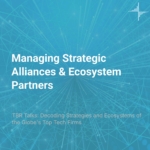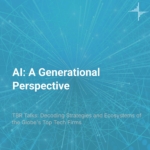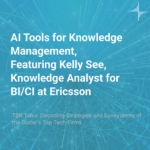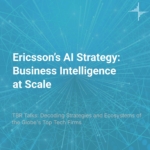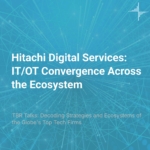Lenovo’s 2026 AI Strategy: GIAC 2025 Key Takeaways
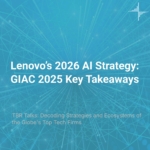
Senior Analyst Ben Carbonneau and Principal Analyst Angela Lambert review Lenovo’s 2025 Global Industry Analyst Conference, where Lenovo provided updates on its overall strategy and ambitions to shift its perception from a PC vendor to a full-stack, end-to-end solution provider. The pair discusses the event’s AI strategy announcement, how this year’s GIAC differed from past years and where Lenovo is differentiating itself from peers
Episode highlights:
• Insights into Lenovo’s Services and Solutions Group and One Lenovo strategy
• Lenovo differentiators
• Key themes from GIAC 2025
Listen and learn with TBR Talks!
Submit your Key Intelligence Questions for Patrick and his guests
Connect with Patrick on LinkedIn
Learn more about TBR at https://tbri.com/
TBR Talks is produced by Technology Business Research, Inc.
Edited by Haley Demers
Music by Burty Sounds via Pixabay
Art by Amanda Hamilton Sy
Lenovo’s 2026 AI Strategy: GIAC 2025 Key Takeaways
TBR Talks Host Patrick Heffernan: Welcome to TBR Talks: Decoding Strategies and Ecosystems of the Globe’s Top Tech Firms, where we talk business model disruption in the broad technology ecosystem from management consultancies to systems integrators, hyperscalers to independent software vendors, telecom operators to network and infrastructure vendors, and chip manufacturers to value-added resellers. We’ll be answering some of the key intelligence questions we’ve heard from executives and business unit leaders among the leading professional IT services and telecom vendors.
I’m Patrick Heffernan, Principal Analyst, and today we’ll be talking about Lenovo GIAC 2025, with Angela Lambert, Principal Analyst for TBR’s IT Infrastructure Practice, and Ben Carbonneau, Senior Analyst for TBR’s IT Infrastructure Practice.
How was this Lenovo event different from past years?
Angela and Ben, welcome back to the podcast. It’s nice to have you guys here.
Angela Lambert, TBR Principal Analyst: Happy to be here.
Ben Carbonneau, TBR Senior Analyst: Always great to be featured.
Patrick: And it was fun traveling with you down to North Carolina to spend three full days, it felt like, with Lenovo at their US headquarters. Super good fun, we could talk the whole time if we wanted to about food, but we should probably talk about Lenovo itself. So, let’s start with Angela, can you give us a sense of how was this event different than the ones you’ve been to in years past?
Angela: Hmm, how was it different? Well, I think what I would say, comparing Lenovo’s event this year to years past, is that what I actually see is a lot of consistency. There’s a lot of consistency in the messaging compared to last year. I think Lenovo has set their strategy in AI, and they are executing on that strategy and we didn’t see really significant departures from that. Which while as analysts, we can say, I’ve heard this before, I think from a strategic services/product standpoint, that’s actually a good thing that we saw so much consistency from last year.
Patrick: And I imagine the temptation for any company, and because we see this all the time, is to ensure that they’re presenting something new, that they’re highlighting something new, that they’re constantly telling you exactly that. You didn’t see this last year. But you’re saying there’s actually a lot of value in, hey, we know what our strategy is going to be and we’re going to execute on it.
Angela: Yeah, I think that we see that, and the value I see in that for Lenovo is the fact that their strategy is a little bit different, particularly from what I see with other infrastructure vendors. Many of them are going really hard at the big CSPs. And it would have been easy for Lenovo to have a knee-jerk reaction and shift their direction a little, but I really think that they’re staying true to focusing on their enterprise and mid-market customer base. And I think- I see a lot of long-term vision in terms of how they’re going to serve that customer base with their AI strategy.
Patrick: Right, that really came through. Ben, was there anything in particular that jumped out at you as being different or the same from years past?
Ben: Sure, yeah. So, I’ve only been to- last year was my first industry analyst conference with Lenovo, and we were fortunate enough to go to Seattle, and the event was held in conjunction with their Tech World event. I think possibly some of the reasons why we didn’t hear a lot of kind of new product launches and things along those lines is because they’re probably saving some of that for January, the Tech World in conjunction with Consumer Electronics Show. So, to be determined on that.
I think also maybe there was a reluctancy to talk too much about storage just because the company’s pending acquisition of Infinidat. But in contrast to maybe last year, I think maybe just from a nerdy technology perspective for me was I didn’t get to see as many of those kind of solutions on a showcase floor. But what was really cool, kind of a closed door sessions for analysts to tour Lenovo’s design space for their PCs, so a bunch of stuff we can’t talk about that we saw in there, but that was really, really cool for somebody who’s as into that kind of nerdy, geeky stuff as I am.
Patrick: And it was cool for me, and I’m not into the nerdy, geeky stuff, but some of the stuff in that design lab was pretty amazing.
Lenovo’s Services and Solutions Group and One Lenovo Strategy
So, I want to talk a little bit about, I know you’ve written up an event perspective on it, and one of the things that caught my eye was you talk about the three different pieces of Lenovo. So, there’s infrastructure, there’s devices, and there’s services and solutions. And you called services the interconnective tissue. What exactly do you mean by that?
Ben: So, I think it kind of ties back to the formation of Solutions and Services Group. So, Lenovo SSG, at one point, the company operated just two businesses. So, Intelligent Devices Group and Data Center Group, which has now turned to Infrastructure Solutions Group. The company, I want to say in 2020, and Angela can check me on that, formed SSG to kind of abstract their services business and really, I think it goes toward, kind of, their whole emphasis. And one thing that really resonated to me throughout the event was that their big goal with marketing is really changing perception from being a PC vendor to being a solutions provider. I think the formation of Services and Solutions Group helps them do that by kind of making that its own separate piece. However, going back to kind of what Angela was saying about recurring themes from the different events that Lenovo’s held, one thing that I know we’ve heard several times is kind of Lenovo’s One Lenovo strategy. And that’s really where I see kind of the business units working together and less in silos to create these solutions and kind of make this Solutions and Services led pivot. I think at the basis, we know Lenovo’s a hardware company, so, they have their client devices hardware, they have their infrastructure hardware. But that Services and Solutions piece over the top, I think, is really what kind of propels them onto that Services and Solutions led Pivot, as well as kind of bringing them up the value chain from just being a hardware manufacturer into being an actual solutions kind of provider.
Patrick: Ben, you said a lot of things in there. I want to pull out two ideas in particular. One, this idea that at its core, in its DNA, they are a hardware, they’re devices, they make stuff. And then also that there’s a perception that the market doesn’t fully understand everything else that they do. So, Angela, did that come through to you, how they’re trying to shift that perception? Was there anything that struck you as a way that they might actually be able to make some progress in making that change in the coming couple of years?
Angela: I think the Lenovo team did share a lot about how they’re changing perceptions, and a lot of that’s through sponsorships and partnerships. Some of those are very public ones, like with Formula One, for example, or FIFA. I was really, really impressed by hearing the story of their customer DreamWorks and how they’ve been able to go in to a place where maybe they were more so focused on selling high-powered PCs in the past to this client, but how they could really show them how they can transform their entire data center using their Neptune servers and actually seeing kind of the metrics on the insane amount of consolidation they did there and really the overall impact on that business. I thought that was a really impressive in a way to demonstrate how they can use their One Lenovo strategy, but also the kind of change in helping the market better understand that they’re not just devices focused. There’s a much broader solution set that they can bring to customers.
Patrick: Yeah, and that customer use case was really good from DreamWorks.
Lenovo’s differentiators
Were there other, either particular sessions or particular customer use cases that stood out for you that are most memorable from, again, three days. For example, and if it’s not a particular use case, like some way that Lenovo differentiates, because we hear a lot of stories, we hear a lot of use cases, we hear a lot of, you know, this client is so happy because this company did X for them. But what were the things that stood out when you took a step back after three days? And you say, okay, this is what actually does differentiate Lenovo. Is it liquid cooling to get all geeky? Is it Hybrid AI Advantage? Is it Device as a Service? What is it that, Angela, maybe you go first. What is it that really struck you as different about Lenovo this time? Not this time, different about Lenovo overall.
Angela: Yeah, I think some of those that you’ve called out tie into my initial comment at the outset of this discussion, which was that I see Lenovo really focusing on how they can innovate and differentiate for their enterprise and mid-market customers. And the sessions we did on liquid cooling, I’ll admit, you know, I may have gone in a little bit of a skeptic on the liquid cooling because everybody has it in some form or another. And I know there’s a lot of engineering that goes on behind that, but what really I better understood after the session was the implications of liquid cooling for an enterprise or for even a company like DreamWorks who is, you know, it’s not tens of thousands or 100,000 employees. Their IT teams are not massive. And when ultimately these companies need to make transitions to liquid cooling, Lenovo has a certain expertise around the services side in terms of assessing their current data centers, assessing what it’s going to take to retrofit this. So, it’s not the same skill set as a company that’s going in and saying, we can build a brand new data center from the ground up. They have a skill set specific to helping their customers who need to work with what they have, make it work better for them, and then also help maintain that in the long term. So that’s where I actually saw the most value out of a liquid cooling session was the real expertise in making it work for someone who’s not a gigantic CSP or GPU as a Service provider.
Patrick: And one of the- during one of the main presentations from the Services and Solutions Group, they mentioned change management, and they talked about how they have change management specialists within Lenovo, something I did not know prior to going to town in North Carolina. And that fits right in with that because you can’t provide all that kind of technology and services you just talked about without including the change management that that goes along with it. So, Ben, how about you? What sort of differentiates, what does differentiate Lenovo?
Ben: I think I’ll talk about Hybrid AI Advantage as the big differentiator that I pulled from the event and then Lenovo’s kind of consistent messaging that we’ve heard more over the last 12 months. But I guess one thing that I would say, just to kind of close the topic on liquid cooling, is that-
Patrick: Because we can’t talk about liquid cooling enough.
Ben: *laughs* Is that for me, I already mentioned One Lenovo. Another slogan that Lenovo loves to put into our ear is Hybrid AI for All. And I really think that Neptune liquid cooling really exemplifies their Hybrid AI for All strategy in the sense that, you know, while all companies, or most of the companies that Angela and I follow as far as infrastructure OEMs have liquid cooling technology, Lenovo’s different flavors of Neptune liquid cooling kind of address different customers at different stages of adoption of liquid cooling and at different stages of, you know, readiness of their environment to accept or be retrofitted for liquid cooling. So that’s one thing that really stood out to me. I think, Nvidia’s come out with RTX Server Edition GPUs, which are an air-cooled solution, you know, for AI compute workloads. But while I think that air-cooled, you know, will probably gain the most traction in on-premises enterprise data centers, well, whether it’s in the core data center or more at the far edge, I also think that there’s a place for kind of different steps of liquid cooling, whether it’s full liquid cooling, like Neptune, the full kind of flagship solution, or whether it’s Neptune Core, which targets just the hottest components, or even whether it’s Neptune Air, which I think is probably where the company is seeing the most traction in kind of converting customers to liquid cooling, where it’s really the smallest step toward liquid cooling. It doesn’t require any new plumbing into their existing environment. I see that as something that’s easier to adopt and definitely drives kind of that services opportunity that Angela alluded to with the retrofitting.
Patrick: And real quick on that, within a year, we should be able to see what the adoption rates are on that are, right? I mean, there should, if it’s going to gain traction, it’s going to gain traction now. So, we’ll know in a year from now, right?
Ben: Yes, I can’t pull them up off the top of my head. I know that Lenovo does state kind of it’s Neptune liquid cooling growth. A lot of times in it’s earnings call transcript, but it’s definitely something that’s been growing quickly. And for a company that doesn’t provide kind of those hard AI server backlog numbers, like some of its competitors, it’s something that I’ve used as a proxy in my modeling to kind of get at that AI server number.
Patrick: Right. And then you mentioned Hybrid AI Advantage. What is it about that that’s different?
Ben: I think the big differentiator for Hybrid AI Advantage is that while all the infrastructure OEMs that we follow, so including Dell and HPE, they all kind of have these joint solution portfolios built around NVIDIA AI Enterprise. What I see as a differentiator for Lenovo, and I know it’s something that they continue to invest in, they’re telling us about expanding their footprint of AI centers of excellence around the globe is their AI library. So that kind of fits into Hybrid AI Advantage where they’re not just trying to sell themselves to build a solution on top of NVIDIA’s software platform, but they’re also coming to customers with a lot more pre-built, almost ready to kind of plug and play AI solutions that were built from their ISV partners. So, I know that kind of stems from their AI Innovators program, and I can’t come up with the date that AI Innovators was founded, but I know that it was before the big rise of ChatGPT. So that’s definitely something where I see, kind of, Lenovo having an advantage over its peers, really, with that strong ecosystem of ISV partners, creating those more plug and play solutions. And then also not just kind of relying on GPU-enabled servers, but something that I see Lenovo doing also is really saying that for some AI workloads, the less intensive AI workloads, a CPU is perfectly fine and maybe the most practical kind of processor to be running these kind of workloads. So, by working with ISVs, creating solutions in conjunction with some of their CPU-oriented edge servers, I think that’s kind of an AI play that I don’t see from other infrastructure OEMs that I follow.
Patrick: Right, because it’s more lucrative to sell GPU solutions, not just say that you can get by with something cheaper and faster, or none of it’s faster, easier, right?
Ben: For sure, yeah. I think there’s a lot of glamour around the NVIDIA name, but an Intel Xeon CPU is still a strong computer processor.
Repeatable solutions
Patrick: So, I want to run something by you both, because you know Lenovo better than I do, and I was focused more on the Services and Solutions Group. And one thing I heard from them was this idea of concentrating their efforts, their go-to-market, their investments in services and solutions that are repeatable, that are replicable. So, it’s not just the single bespoke solution or the single offering aimed at a particular client, it’s something that they can bring to lots of other clients that they know they can actually scale within Lenovo within their suite of offerings. And what struck me about that is how I heard the exact same thing from Fujitsu earlier in the summer, and I heard the exact same thing from Hitachi earlier this year as well. And so it makes me think there’s a bit of a kind of a hardware, DNA, a mindset that says, in the same way that you build a device and you build it many, many, many times, you’re also building a service and you’re building it many, many, many, many times. So, is it accurate for me to think about that’s how Lenovo thinks about the world they play in and what they’re good at, and that’s why they’re looking to replicate? Or is there something more behind that I’m missing?
Angela: I do think that’s a trend you’ll see among hardware providers, and I think it’s existed in previous tech iterations, thinking back to IOT or edge computing. Whenever there’s a situation where you have a piece of hardware that has almost an infinite number of potential applications or use cases, what these vendors want to do is identify some of the maybe most applicable ones that can benefit the most customers the most quickly and roll those out. And over time, I think those will evolve. So, while it’s not, I don’t think it’s particularly unique to Lenovo, I did see that unsurprisingly, Lenovo’s focusing on some of the areas where they’re really strong. So, they’re focusing on AI in manufacturing solutions. They’re focusing on it in supply chain, in retail, in safety.
Patrick: So those are three areas where they’re sort of customer zero as well. They manufacture, they have a complex supply chain, they are in the retail space. So, right? I mean, that’s part of what they’re bringing to the table.
Angela: Absolutely, they’re very focused on, as I think it’s safe to say, Linda Yao would say, eating their own dog food. They are absolutely customer zero and doing many of those things internally and then bringing that to their customer base.
Patrick: Right. Eating their own squirrel fish, perhaps?
Angela: The squirrel fish was-
Patrick: We’ll get back to that in just a minute.
Key themes from GIAC
A couple last questions as we wrap up here. I want just some of the broad themes that came out. I know we’ve touched on a bunch of them so far, but just things that you sort of walked away with and maybe, if not necessarily a broad theme or a key theme from the event, just was there anything that changed your mind? Did you walk away, did you get on the plane leaving North Carolina and think, okay, I have a different view of Lenovo because of this? Either of those things.
Ben: I think even more powerful than maybe getting on the plane with a different view of Lenovo was actually a PC session that I was in that really had me getting on the plane thinking differently about the PC market. And it’s something that I’ve followed in really since the beginning of my time at TBR. And it’s always been a market that I saw as kind of almost as close as to being commoditized as really any market that we follow in tech. But what Lenovo demonstrated to me is that, you know, with going through their design lab, but even more with the software that the company’s building around their devices, is that they are going to be driving differentiation in the market. And I think there’s some things that will have to kind of wait to be publicly announced. But I do see the company, whether it’s with their kind of one AI multiple devices strategy and following Apple into that devices ecosystem play, I think Lenovo might be better equipped than, I guess, any other devices company that I’ve seen yet in executing on that. And I think, one quote that really stuck with me, I like this one, and I can’t remember which executive said it, but the quote was, you only date your hardware provider, but you marry your software provider. And I thought that quote was excellent. And I think that by building in that software layer, the kind of unified devices ecosystem, the whole one AI multiple devices play that Lenovo is doing, I think they do make their devices’ ecosystem a little bit stickier and do drive differentiation in a market that I’d otherwise seen as very commoditized.
Patrick: Yeah. I want to come back to all that in a minute. But Angela, I want to give you a chance to weigh in. What was your key theme or your sort of key takeaway or what changed for you?
Angela: I think, so like I said at the beginning, there was a lot of consistency in Lenovo’s messaging, particularly on AI strategy. What I think stood out to me was helping me remember that Lenovo is a very engineering and design-oriented company, and they’re doing just so much focus on that. And they’ve built much on that with the services group. But seeing that underpinning almost everything that we were shown throughout those three days was very powerful.
Patrick: Yeah, and you mentioned AI, and there was a really good section where they talked about in particular, agentic AI and the need to marry both intent and context and what that actually looks like in the agentic AI space, which for me was just a really great way of thinking about it. I hadn’t put it quite together like that. Ben, last year, I went to Seattle with you and we- and I learned that I actually am interested in liquid cooling. Now it’s possible I’m going to care about PCs, which is a little shocking. We’ll have to revisit this in a couple of months and see if I actually, if you can actually make me want to care about PCs. Maybe, who knows?
Ben: After Tech World and Consumer Electronics Show, you’ll be drooling over PCs.
All: *laughs*
Patrick: You knock yourself out and go to that. I’m not going to Vegas.
Final thoughts
So, let’s wrap up. Last thing, it was a culinary delight, let’s just say that. We had a phenomenal couple of meals there. So, what was your highlight when it comes to the food, because these trips, you know, I mean, you gotta go someplace and eat well. And we went someplace and ate well. So, what was your favorite part of either of the dinners?
Angela: Oh boy, squirrel fish far and away.
Patrick: Squirrel fish was really good.
Angela: Wow.
Patrick: Yeah.
Angela: Wow, that’s all I can say, blown away.
Ben: For me, lobster and grits cannot be beat anywhere, no matter how it’s made and it was excellent as it was prepared.
Angela: Not even the tomahawk steak. I’m a little bit shocked.
Ben: Tomahawk steak was great, but lobster and grits, it’s a different tier for me.
Patrick: The bourbon tasting of three bourbons and two ryes, that was fantastic. Although I have to say the lobster and grits was good. There was no cheese in it, which I really liked. I thought it was very good. Peking duck was great. The squirrel fish though, squirrel fish was just insane.
Angela: And it was gorgeous.
Patrick: And it was gorgeous. I feel like you can ask Haley if there’s a way to put a picture of the squirrel fish along with this episode. So, Ben, Angela, thank you so much. We will revisit this again probably next year, if not sooner. I don’t know what else Lenovo’s got in store for us this year, but as they roll out new stuff, we’ll chat again. Thank you.
TBR Talks: Decoding Strategies and Ecosystems of the Globe’s Top Tech Firms
Angela: Thanks.
Ben: Thank you.
Patrick: Tune in next week for another episode of TBR Talks. Don’t forget to send us your key intelligence questions on business strategy, ecosystems, and management consulting through the form in the show notes below. Visit tbri.com to learn how we help tech companies, large and small, answer these questions with the research, data, and analysis that my guests bring to this conversation every week.
Once again, I’m your host, Patrick Heffernan, Principal Analyst at TBR. Thanks for joining us, and see you next week.
Join TBR Principal Analyst Patrick Heffernan weekly for conversations on disruptions in the broader technology ecosystem and answers to key intelligence questions TBR analysts hear from executives and business unit leaders among top IT professional services firms, IT vendors, and telecom vendors and operators.
“TBR Talks” is available on all major podcast platforms. Subscribe today!



